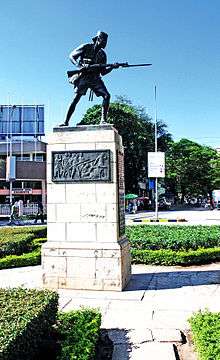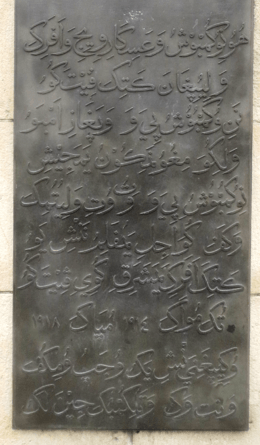Askari Monument
The Askari Monument in Dar es Salaam, Tanzania, is a memorial to the askari soldiers who fought in the British Carrier Corps in World War I. It is located at the center of a roundabout on Samora Avenue at the perpendicular junction to Maktaba Street and Azikiwe Street, a place that reportedly also marks the exact center of downtown Dar. It was unveiled in 1927.
| Sanamu ya Askari (Swahili) | |
 | |
| Coordinates | 6.8166341°S 39.2895626°E |
|---|---|
| Location | Dar es Salaam, Tanzania |
| Designer | James Alexander Stevenson |
| Material | Bronze |
| Opening date | 1927 |
| Dedicated to | British Askari Carrier Corps |
| Website | www |
The main feature of the monument is "The Askari",[1] a bronze statue of a soldier. It was realized in the United Kingdom by British sculptor sw:James Alexander Stevenson, who worked for Westminster's Morris Bronze Founders. Stevenson signed the statue with pseudonym "Myrander". Before being sent to Dar es Salaam, the statue was exhibited for a while at the Royal Academy, receiving critical praise. The soldier has a rifle with a bayonet pointed towards the Dar es Salaam harbour.[2] The statue stands on a pedestal. On the narrow sides of the pedestal are plaques with a dedication in Swahili (Arabic and Latin script) and English; on the wide sides of the pedestal are 2 pictorial plaques showing fighting African soldiers and the carrier Corps.
In the place where the Askari Monument is located, there used to be another statue, namely that of German explorer and army Major Hermann von Wissmann, governor of German East Africa in the late 19th century. This former statue, unveiled in 1911, represented Wissmann standing, one hand on his hip and one on his sword, looking towards the harbour; at his feet, an African soldier covering a dead lion with a German flag. When the British entered Dar es Salaam in 1916, they removed this statue along with those of Karl Peters and Otto von Bismarck.[3]
The monument in Dar es Salaam belongs to a group of three Askari Monuments that were all unveiled the same year in different parts of what was then British East Africa: the other two are at Mombasa and Nairobi.[4]
Gallery
 Inscription
Inscription Memorial inscription in Swahili - Arabic script
Memorial inscription in Swahili - Arabic script Memorial inscription in Swahili - Latin script
Memorial inscription in Swahili - Latin script memorial plaque - fighting African soldiers
memorial plaque - fighting African soldiers Memorial plaque - Carrier Corps
Memorial plaque - Carrier Corps
Notes
- Tanzania
- V. The Rough Guide to Tanzania, Rough Guides 2006, ISBN 1-84353-531-9.
- V. Hodd, p. 341
- V. Samson, p. 161
References
- Michael Hodd, East Africa Handbook, Footprint Travel Guides 2002, ISBN 1-900949-65-2.
- Anne Samson, Britain, South Africa and the East Africa Campaign, 1914–1918, J. B. Tauris 2005, ISBN 1-84511-040-4